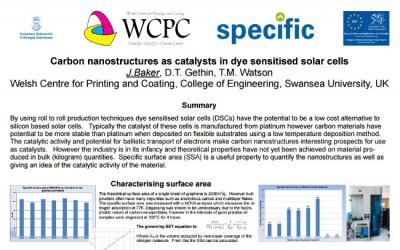Swansea University researchers, along with Haydale, examined the feasibility of using carbon materials as catalysts for dye sensitized solar cells (DSCs), a potentially low-cost alternative to silicon-based solar cells.
Haydale HDPlas low pressure cold plasma technology was used to introduce functional groups onto graphene. This is a process known to improve the material’s performance as a counter electrode in DSCs as it improves the dispersion of carbon nanomaterials without the need for surfactants and decreases the density of the powder without increasing the SSA (Specific Surface Area a useful way to quantify nanostructure and estimate catalytic activity).
The results showed that high surface area GNPs (XGS material) have the most potential for transparent applications because they require less loading by mass compared with lower surface area GNPs (GT material) to achieve the same effect. It was also shown that flexible electrodes with a printed GNP catalyst achieved 77% of the efficiency of sputtered platinum.
Haydale is a UK-based supplier of split plasma treated carbon materials - graphene flakes/GNPs, graphene-based inks and CNTs. The company also offers customer R&D services and a lab for hire in the UK. Haydale facilitates the application of graphenes and other nano-materials in fields such as inks, sensors, energy storage, photovoltaics, composites, paints and coatings. Haydale has developed a patent-pending proprietary scalable plasma process to functionalize graphene and other nanomaterials. This enabling technology can provide Haydale with a rapid and highly cost-efficient method of supplying tailored solutions to enhance applications for both raw material suppliers and product manufacturers.
